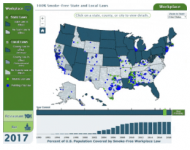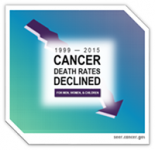The NCI Tobacco Policy Viewer is an interactive online resource for the mapping, querying, and downloading of historical smoke-free policy data in the United States. The tool reveals variation across U.S. cities, counties, and states by the types of indoor areas that are smoke-free, length of time since the smoke-free policy came into effect, and number of people who are protected by the policy. This information was obtained from the American Nonsmokers’ Rights Foundation.
The NCI Tobacco Policy Viewer provides access to the following statistics at state, county, and city levels:
Laws requiring 100% smoke-free non-hospitality workplaces Laws requiring 100% smoke-free restaurants Laws requiring 100% smoke-free freestanding barsFor more information, see the companion paper that describes the development of the NCI Tobacco Policy Viewer:... Read more
The Annual Report to the Nation on the Status of Cancer (ARN) is a collaborative update from the National Cancer Institute, American Cancer Society, Centers for Disease Control and Prevention, and the North American Association of Central Cancer Registries. It provides the most recent cancer data on rates of new cases, death rates, and trends for the most common cancers in the United States. This year, the Annual Report to the Nation on the Status of Cancer has been published in two different parts. Part I of the report shares national rates and trends of different types of cancers, while Part II focuses on prostate cancer.
PART I HIGHLIGHTS
The Annual Report to the Nation on the Status of Cancer, Part I: National Cancer Statistics provides updates on rates of new cases and deaths for different types of cancers. The main conclusions from the report include: the rate of new cases of cancer continued to decrease for men but remained stable among women; significant... Read more
Cancer is a major public health concern that affects more than 1.6 million Americans each year. It is the second leading cause of death in the United States. Although the cancer death (mortality) rate continues to decline across all populations, certain groups suffer a greater burden of disease, and the financial and emotional hardships caused by a cancer diagnosis persist. Thus, our nation has made large investments in cancer care and research.
The Cancer Trends Progress Report is an annual report published by the National Cancer Institute’s (NCI) Division of Cancer Control and Population Sciences (DCCPS). The report summarizes the nation’s advances against cancer in relation to Healthy People 2020 targets. It includes key measures of progress along the cancer control continuum—including prevention, early detection, diagnosis, treatment, life after... Read more
On July 12-14, 2017, the Surveillance, Epidemiology, and End Results Data Management System (SEER*DMS) 2017 Face-to-Face Meeting took place in Rockville, MD, at the National Cancer Institute’s (NCI) Shady Grove campus. The purpose of the meeting was to discuss enhancements to SEER*DMS and updates to SEER Program initiatives. SEER*DMS is a centrally designed data management system that allows registries to submit cancer data to the SEER Program. Developed in 2000 and first deployed in 2005, SEER*DMS also provides support for all core cancer registry functions, including importing, editing, linking, and consolidating data and producing reports. Since 2011, the SEER Program has taken steps to invest in and implement enhancements to SEER*DMS. In 2015, health informatics experts conducted a review of SEER*DMS and provided several recommendations for enhancement.
One recommendation included increasing transparency and clarity of changes and enhancements coming to SEER*DMS, and... Read more
Cancer is a major health burden, with an estimated 1,688,780 new diagnoses in 2017. Between the difficulty of receiving a cancer diagnosis and the complexity of cancer data, patients and loved ones may have difficulty interpreting cancer information. The National Cancer Institute’s (NCI) “Did You Know?” video series breaks down cancer statistics in layman’s terms and includes easy-to-understand charts and graphs.
The “Did You Know?” video series was created through a partnership between NCI’s Surveillance, Epidemiology, and End Results (SEER) Program and the NCI Office of Communications and Public Liaison (OCPL). In under 5 minutes, each “Did You Know?” video discusses a specific cancer type, such as bladder cancer, or a cancer-related topic, such as cancer survivorship. Each video presents statistics that include numbers, rates, and trends in new diagnoses, 5-year survival trends, and mortality rates and trends. The statistics are given for different racial and ethnic... Read more
- 1 of 2
- next ›





